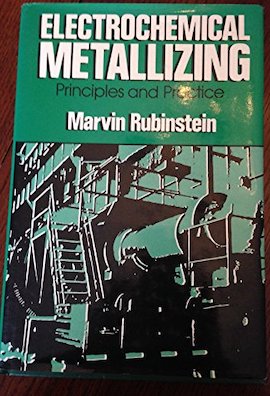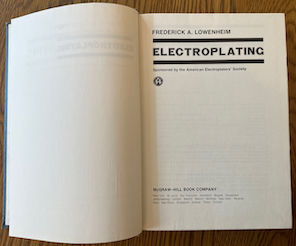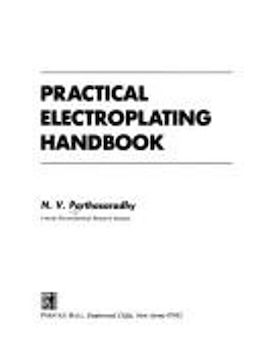
Curated with aloha by
Ted Mooney, P.E. RET

The authoritative public forum
for Metal Finishing 1989-2025

-----
Iron Plating (electrodeposition of iron) for art, research, hobbies, & non-industrial
Q. I want to pipe ammonia
⇦ this on
eBay or
Amazon [affil links] , and from my research it does NOT attack iron but virtually all other metals.
I also want to use piping with magnetism so copper would be ideal if it was not attacked.
So will it be POSSIBLE to iron plate the inside of a copper pipe about 150 to 200 mm long.
Then I want to see how much my magnetic field is affected by the iron plating.
Entrepeneur Research - Pretoria South Africa
March 21, 2022
A. Hi Chris. I think it would be more practical to use 300-series stainless, which is essentially non-magnetic, although not 100% so. I think you will have problems with code compliance if you use copper pipe; iron-plated copper doesn't sound very safe.
If absolutely necessary iron plating of the I.D. of copper pipe can be done, although you would also have to think about whether all the copper at the joints is covered and there are no sneak paths through pipe threads or whatever. Again, robust, reliable, pore-free, iron plating of a pipe I.D. probably can be done, but it is not something easily dispatched.
Luck & Regards,

Ted Mooney, P.E. RET
Striving to live Aloha
finishing.com - Pine Beach, New Jersey
⇩ Related postings, oldest first ⇩
Q. Hello, I have a question that I hope you might shed some light on. Thanks in advance for any help you might offer.
As part of a "tinkering" experiment, I find that I have a need for a strip of iron that has been electroplated to a thin, non-magnetic surface. The approximate dimensions being, 6" x 1" x 1/8". I have read that iron was electroplated in the past, but is not done much anymore.
After looking over your very nice website, I realize that I probably don't want to try this myself, unless plating iron doesn't involve the environmental hazards associated with the other commonly plated metals.
Can you give me an idea as to what is required to plate iron, and possibly referrals to someone that might be set up for iron plating.
If I win the lottery tonight, cost won't be a factor, but until that happens can you give me an idea what a project like this might cost ? Thank You,
- Arlington, Texas
2000
A. Iron plating is not commonly done because there are usually other, better alternatives. I say "usually" because iron plating is cumbersome and the deposit will easily rust. But iron also has its attractions (ha ha) - it is very hard and can withstand high temperatures without crazing. In any case, you definitely don't want to try iron plating in a non-industrial setting. Most plating is done out of acidic fluoborate baths or the more corrosive chloride chemistry.
Depending on the geometry of your part and the thickness of the deposit you're looking for, contracting out a job such as yours shouldn't break the bank. So don't run down to the Lotto office just yet.

Megan Pellenz
- Syracuse, New York
Q. I would like to know how to plate with iron. I assume it would be called 'electro iron plating'. There are thousands of pages about plating 'onto' iron but I can't find any information as I say about plating 'with' iron. I have seen one reference to using Iron sulphate in solution with no other particulars. I have a situation where I would just like to build up a worn piece of iron (steel), the pivot bearing surface of an old double barrel shotgun. I know I could use say, copper and then nickel, but there should be a way to just plate with the iron I would think. Any help on this would be appreciated.
Thank you,
hobbyist - Pagosa Springs, Colorado, USA
2003
Electrochemical Metallizing by Marv Rubinstein

on AbeBooks
or eBay or
Amazon
(affil links)
A. Hi Robert. Yes it is possible to do iron plating. To the best of my knowledge all soldering iron tips are iron plated (that's just one layer of their plating though). A few other things are iron plated, but it's not one of the really popular processes. The subject is covered in the Metal Finishing Guidebook (any year since 1997 except 2004).
However, iron is rather difficult to plate because of the multiple oxidation states of iron which interferes with solution life, requires filtration, prevents useful air agitation, etc. Do you have prior electroplating experience that you can bring to bear on taming this tricky process? Further, it's probably not the right material for this application of building up worn parts. You probably actually need to do nickel plating for integrity of the coating.
Indispensable for your situation is Marv Rubinstein's Electrochemical Metallizing, the authoritative text on brush plating repairs. Good luck.

Ted Mooney, P.E.
Striving to live Aloha
finishing.com - Pine Beach, New Jersey
![]() I was the one that asked about the iron plating ... Thanks Ted.
I was the one that asked about the iron plating ... Thanks Ted.
hobbyist - Pagosa Springs, Colorado, USA
2003
2003
A. Iron plating solution (19th century):
40 gm iron sulphate
200 gm potassium-sodium tartrate
⇦ this on
eBay
or
Amazon [affil links]
0,6 lit water
0,4 lit ammonia(25%)
iron anode
- Zagreb,Croatia
![]() Hi - I just found out about the additional reply to my letter on iron plating. Thanks to Goran Budija.
Hi - I just found out about the additional reply to my letter on iron plating. Thanks to Goran Budija.
hobbyist - Pagosa Springs, Colorado, USA
2007
Q. Well, I have requirement to plating iron on copper profiles. Although, I found on internet some method for this process (e.g. ferrous(II) chloride, calcium chloride etc.) but I did not found anything about pretreatment of copper before iron plating.
So, if someone can proceed me in total process of iron plating of copper (pretreatment condition, plating condition (current density, composition of electrolytic solution, etc.) I will be grateful.
Thank you and best regardes
ktf - Split, Croatia
2005
A. Try to visit (or contact via e mail) Electrochemistry institute in Zagreb. They have some very good books on electroplating subject (especially Dettner/Elzes handbook Hanbuch der galvanotechnik)! Good luck!
Goran Budija- Cerovski vrh Croatia
Q. I am a hobbyist mainly in the electronic field. I understand that lead-free soldering is the new trend. When I started soldering PCBs with lead-free solder I found the solder iron tip decay rate is very high. Then I referred to the internet and I saw that the high Tin (Sn) content in the lead-free solder is eating the copper tip. Further I understand that lead-free soldering irons have special tips which have been iron plated on the copper bit to prevent this fast decay. My soldering iron has no such bits available in the market and I thought to make and try one tip myself. Therefore, can you describe how to electroplate Iron onto a copper soldering bit (a copper rod)
Thank you.
Hobbyist - Negombo, Sri Lanka
2005
A. Iron plating is more difficult for hobbyists than some other types of plating, Gamini, because iron has multiple oxidation states. Without proper attention, or with exposure to air, the iron will oxidize to the higher oxidation level from which state it is not longer soluble and can't be plated -- so avoid air agitation.
I think a hobbyist with no plating experience will have a significantly harder time successfully doing iron plating than starting with something else like nickel or zinc, so if you are determined to learn to electroplate, I'd suggest you practice with nickel plating first.
Some plating references don't even cover iron plating because it's rather uncommon, but 6 baths are discussed in Lowenheim's
"Electroplating" →
The simplest is probably the
240 g/l FeSO4.6H2O bath operated at
pH of 2.8-3.5 and
temperature of 32-65 °C,
current density 400-1000 A/sq. m.
Good luck!

Ted Mooney, P.E.
Striving to live Aloha
finishing.com - Pine Beach, New Jersey
A. I have found a simple and reliable plating solution for plating hard iron onto copper soldering tips:
1 liter Ferrous (II) Chloride 0.86 Molar (11% conc),
240 grams ferrous sulfate
⇦ this on
eBay or
Amazon [affil links] heptahydrate FeSO4.7H20, and
150 grams Sodium Citrate Na3C6H507.
I use about one cup of solution with a malleable cast iron washer in the bottom as a spent anode. Just hang the soldering tip into to solution as the cathode at about 50-100 mA and plating time and finish will vary with temperature and current. This produces a very hard and durable iron finish at low temperatures.
Michael Guerre- Claremont, California USA
2007
![]() Thanks a lot, Michael!
Thanks a lot, Michael!

Ted Mooney, P.E.
Striving to live Aloha
finishing.com - Pine Beach, New Jersey
Artist wanting to iron plate on copper
Q. I am an artist who wants to iron plate copper vessels and flat copper. In "Enamels Enameling Enamelists" by Glenice Lesley Matthews there is a vessel by June Schwarcz that is iron plated and is what I would like to achieve. Thank you, I appreciate any help that you can offer, Marie Maretska
Marie MaretskaArtist - Medford, Oregon USA
2006
A. Try to find plating shop that can iron plate your works. You can do it yourself too. Simple iron plating solution:
iron sulphate 180-250 gm
iron chloride 42 gm
ammonium chloride 20 gm
water 1 lit,45 C temp.,1-8 a/dm2
iron anodes, pH 4,5-6
- Zagreb,Croatia
2006
Plating Stainless Steel with Iron
Q. I make knives for throwing. A large number of my customers like the properties of stainless steel, but require period materials for reenactment (i.e. natural materials for grips and ferrous/carbon steel for the blades. I would like to coat the stainless blades I purchase from India/Pakistan/China/USA/UK with iron to give these blades the course black/blued/browned finishes common in the 17th-19th centuries. Basically the period finishes on modern steels.
How would I electroplate iron onto stainless steel? Can I set up the process economically myself, or would I need to send it out to a service provider? I am not sure this process will be widely accepted, so I would like to produce a small batch to test the market.
- Houston, Texas USA
2006
A. It would be prohibitively expensive to set this up yourself for a non-proven market, but there are plating shops who could do iron plating onto the stainless knives for you. It will take some shopping since iron plating is an uncommon process and plating onto stainless is a somewhat uncommon process.
But are you sure you can't find a 'rust paint' that will serve your needs? It would be much cheaper and easier. Good luck!

Ted Mooney, P.E.
Striving to live Aloha
finishing.com - Pine Beach, New Jersey
2006
A. In my free time I make engravings (dry-points, etchings, etc.) and I electroplate the copper with iron to get a harder surface and to be able to print more copies.
I have obtained the best results (brightness + hardness) with alkalene-organic baths (pH =10-12): I have used for years the ferrocyanure bath from Boettger and now a sodium gluconate + Fe-sulphate bath (easier to prepare).
(Note1: pH high alone makes iron and nickel deposits very bright and hard, but in the case of iron, inorganic baths do not work with high pH as Fe hydroxide precipitates).
(Note2: I tried an inorganic, high pH, nickel bath and worked wonderfully but nickel is difficult to remove from copper without any damage to the plate and for this reason is not much appreciated by the artists which often want to modify the plate).
But these organic baths do not take any iron from the anode, owing to the high pH, so they have to be replaced often, and are very expensive.
Q. Is there a way to return to the bath the lost iron, without changing the properties of the bath? I am thinking of using iron hydroxide but I fear that it will be not be solved as the pH is so high.
Hobbyist - Aiguafreda (Barcelona), SPAIN
2007
Environmentally kind iron electroplating
Q. Greetings ... and peace,
I am desiring to work out a method for "growing" iron metal in an environmentally kind way at every stage of the process - from the extracting of the raw materials from the earth to the final product. I'm familiar with the vague fundamentals of electroplating iron, and am sure that this can be done ... but I need a more detailed and concise picture of the situation. Are there any books or free articles that anyone here knows of that would give me a very detailed description of the issues that arise in specifically electro-plating iron (most likely at first onto natural twine coated with natural rubber ... maybe caked with graphite powder for initial conduction ability - how strong an iron wire or rod could this plate too?).
Thanks for any feedback on this issue.
Sincerely,
student and designer - Austin, Texas, U.S.A.
2007
A. Hi Douglas. There is a chapter on iron plating in the Metal Finishing Guidebook. But I'm personally not aware of electroforming of iron to structural integrity, and tend to doubt its suitability. Copper or nickel seem more promising if they would meet your needs. Good luck.

Ted Mooney, P.E.
Striving to live Aloha
finishing.com - Pine Beach, New Jersey
How to set up an Iron plating bath
Q. Hi I am working on setting up an Iron plating bath. I am looking for info on the design of iron plating tanks. I also had a question on anode and rectifier type. I am using ferrous chloride and calcium chloride on the bath composition.I would like to know if there is either a table or a formula that I can use to determine the tank size needed for a given surface area to be plated. Thanks
Johanna CruzSTUDENT - San Jose, California
June 30, 2008
A. Have your library get a copy for you to check out of "Modern Electroplating"
[on
AbeBooks,
eBay, or
Amazon affil links]
edited by Lowenheim. Mandich may have edited the latest version. At 90 °C, there is not much that will work for a tank.
A well reinforced tank of CPVC may work. If you are a lab project, heavy wall pyrex beakers [beakers on
eBay
or
Amazon [affil links] may work. Watch out on hotplate heaters as the whole beaker may jump as much as two inches once in a while.
Power is DC at about 20 amps per square foot. Anode to cathode distance is normally 4 inches or so.
The book has a LOT of good information on this process. Fe III causes problems.
- Navarre, Florida
July 1, 2008
Iron Plating on Aluminium
Q. I have an aluminium base that must be aluminium. On it I have to plate iron. I have filings in the form of black oxide.
The question:
Can I use dilute muriatic acid with hot water with the filings and a steel terminal to plate the aluminium?
I've never done this before but I'm somewhat versed in the process and have the necessary precautions.
September 7, 2015
A. Hi John. This sounds doubtful. You have two problems to start with that demand some experience. First, you can't plate directly onto aluminum, but must zincate it first. Second, unlike the situation with some other metals, it can be hard to keep the iron dissolved at the right oxidation state (ferrous), as it will want to oxidize to the ferric state, from which it can't be plated.
I'm not saying it can't be done; but if you haven't done plating before, you might want to try some easier stuff first :-)
It might help if you told us why you need to plate with iron rather than something easier like nickel, and how thick the iron plating needs to be, and what you plan to do to keep the iron plating from quickly rusting.
Luck and Regards,

Ted Mooney, P.E.
Striving to live Aloha
finishing.com - Pine Beach, New Jersey
Q. I found a reference to plating iron (copper, aluminium, etc.) in patent US630246
I ordered the oxalic acid, ammonium sulphate
⇦ this on
eBay or
Amazon [affil links]
and trisodium phosphate
⇦ this on
eBay
or
Amazon [affil links]
but I have very little experience in plating. I'll try to make it work, but I would like to hear some experts on it.
- Clearwater, Florida
September 22, 2015
A. Hi John. That 1899 patent covers a method to activate aluminum for electroplating, and is not where I would have started in attempting electrodeposition of iron. Further, the hydrofluoric acid it employs is probably the most dangerous material used in a plating shop. Or maybe you just gave us the wrong patent number.
Anyway, I'd suggest trying a plating text first. Lowenheim's "Electroplating"
⇦[this on
eBay ,
Amazon,
AbeBooks affil links]
lists 6 iron plating baths. Parthasaradhy's "Practical Electroplating Handbook" offers a number of formulations.
Lowenheim's "Modern Electroplating"
[on
AbeBooks,
eBay, or
Amazon affil links]
has a pretty broad chapter on it and might be your best choice. Good luck.
Regards,

Ted Mooney, P.E.
Striving to live Aloha
finishing.com - Pine Beach, New Jersey
September 2015
A. I would guess that John Wilkinson means patent US7235165 B2, the reagents he describes are the same as those in the above.
https://www.google.com/patents/US7235165
- County Wexford Ireland
December 3, 2017
![]() Thanks for unearthing that information, Jon. What is the thrust of that patent though, if you are familiar with it? I've read its claims and don't understand what it is claiming as patentable, or even unusual. Instructions to 3rd-grade schoolchildren about how to electroplate zinc or copper with kitchen ingredients like vinegar
⇦in bulk on
eBay
or
Amazon [affil links] and salt also start with no zinc or copper in the solution -- so it can't just be that he is starting with no metal ions in solution :-)
Thanks for unearthing that information, Jon. What is the thrust of that patent though, if you are familiar with it? I've read its claims and don't understand what it is claiming as patentable, or even unusual. Instructions to 3rd-grade schoolchildren about how to electroplate zinc or copper with kitchen ingredients like vinegar
⇦in bulk on
eBay
or
Amazon [affil links] and salt also start with no zinc or copper in the solution -- so it can't just be that he is starting with no metal ions in solution :-)
Regards,

Ted Mooney, P.E. RET
Striving to live Aloha
finishing.com - Pine Beach, New Jersey
A. Iron plates quite well from a simple ferrous sulphate solution.
Your proposed solution appears to contain no source of iron !
You should also know that oxalic acid is highly toxic.

Geoff Smith
Hampshire, England
Q. Hello there - I am an artist in New Zealand working with electroforming in a very experimental way. I have been electroforming with copper very successfully and am now working with iron. I have created a solution with vinegar and am now forming on to copper wire which is going well. My question is: is the gas that is coming off the electroforming object toxic in any way? There is certainly a lot of bubbling. No obvious smell. This forum is a fantastic resource, thank you!
Shelley Simpsonshelleysimpson.co.nz - New Zealand
March 6, 2021
A. Hi Shelley. No toxicity.
You may want to see our FAQ on Faraday's Law because it explains this a little slower and more carefully, and with graphics, but ...
When you do electroplating or electroforming, electrons are pulled away from the positive pole (anode) and are pumped through the power supply and copper wiring to the cathode. The desirable result of this is changing the neutrally charged metallic copper atoms of the anode into positively charged copper ions which will dissolve into solution and by attracted to the negative pole (cathode); while at the cathode those electrons re-merge with the copper ions to become once again copper metal.
But what the electricity also does is separate some amount of the water, H20, into hydrogen gas which evolves at the cathode and oxygen which evolves at the anode. These are not toxic whatsoever but can produce a champagne or ginger ale effect entraining some of the solution into the air. That entrainment can be an issue when there are toxic materials in the solution, for example chromic acid when doing chrome plating. But when your solution is vinegar the worst that could happen is entrainment of some resultant vinegar.
By the way, although there will always be some bubbling, there should not be a lot. That is an indication that the plating solution can't keep up because you are using too much current.
Luck & Regards,

Ted Mooney, P.E. RET
Striving to live Aloha
finishing.com - Pine Beach, New Jersey
Q, A, or Comment on THIS thread -or- Start a NEW Thread

